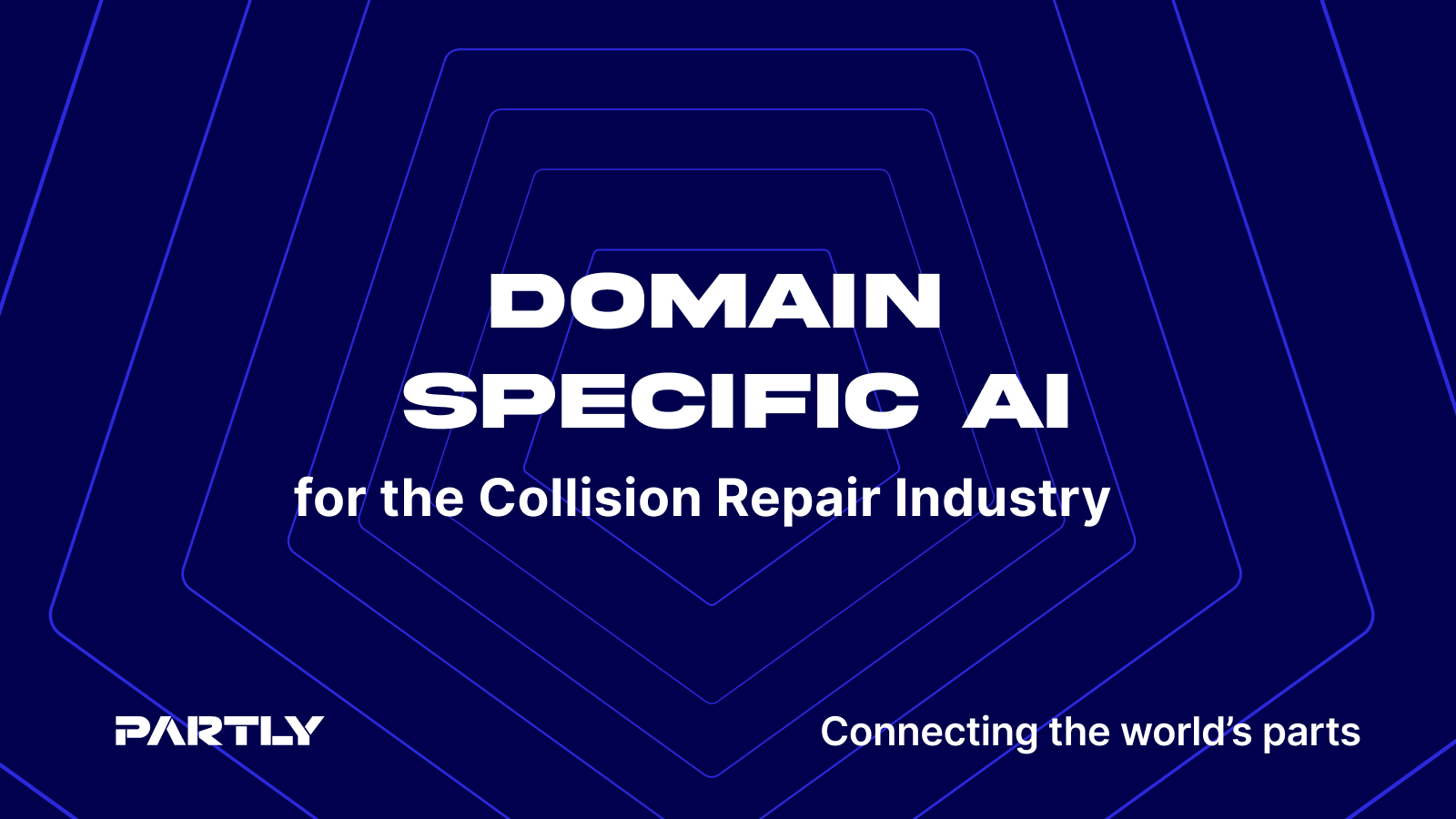Overview
Most AI is built to be general-purpose, trained on massive amounts of diverse data to handle a wide range of tasks reasonably well. As AI adoption has accelerated, a clear pattern has emerged: this approach works well for common tasks, but struggles in industries like medicine, law, and finance where precision is critical. That's why we're seeing the rise of domain-specific AI, trained on specialized data and designed to solve the unique problems and workflows of a particular industry.
Partly has been building domain-specific AI for the collision parts industry since 2020. We're a team of automotive experts and world-class engineers from companies like Rocket Lab, Google, and Apple. We've invested millions developing the only AI infrastructure specifically designed for complex parts systems and workflows.
In this whitepaper, we'll explore where general AI is suitable for the industry, why it falls short for parts processes, and how Partly's domain-specific approach removes friction and reduces inefficiencies across the parts supply chain.
"You can't build a parts solution on general AI. You need the right foundation."
Where General AI Works
General-purpose AI is already delivering measurable results across the collision ecosystem, from bodyshops to dealerships to dismantlers. Here are examples of areas where general AI is well-suited:
- Customer Service Automation: AI-powered voice and chat systems handle appointment scheduling, sales inquiries, and customer communications 24/7, deflecting millions of calls while maintaining high satisfaction scores. Examples include Numa and Capacity.
- Content Generation: AI generates vehicle descriptions, marketing content, and product listings at scale, with companies seeing significant increases in leads and SEO performance. Examples include CarMax and Phyron.
While these applications demonstrate AI's value, the largest opportunity for transformation lies at the core: parts processes, from vehicle estimation to procurement to order management. Yet general-purpose AI, despite its success elsewhere, falls short for these critical workflows.
AI Purpose-Built for Parts
"The largest opportunity for transformation lies at the core: parts processes."
Parts processes are overwhelmingly manual today. Parts teams spend hours fixing incorrect and incomplete estimates, copying and pasting between systems, and researching parts across different manufacturer catalogs. Both bodyshops and suppliers lose time and money to these inefficiencies.
Domain-specific AI is needed because:
- Precision Requirements: Parts identification must be exact. The right part for a specific VIN that fits perfectly and satisfies work provider requirements. Getting it wrong is costly, increasing key-to-key time and creating friction throughout the repair process. General AI is fundamentally designed to generate probable matches, not exact ones.
- Data Quality Issues: Accurate fitment data requires expensive manufacturer licensing and isn't accessible online. General AI learns from publicly available information, which is fragmented and often unreliable, and misses critical context like part number supersessions, approved alternates, and mid-year production changes that affect compatibility.
- Parts Industry Complexity: Automotive parts come with dependencies, variants, and exceptions that aren't immediately obvious. A bumper replacement might require specific clips and brackets. Trim levels affect which components are compatible. Mid-year engineering changes can make what seems like an obvious match completely wrong. General AI doesn't understand these relationships or the domain knowledge required to navigate them.
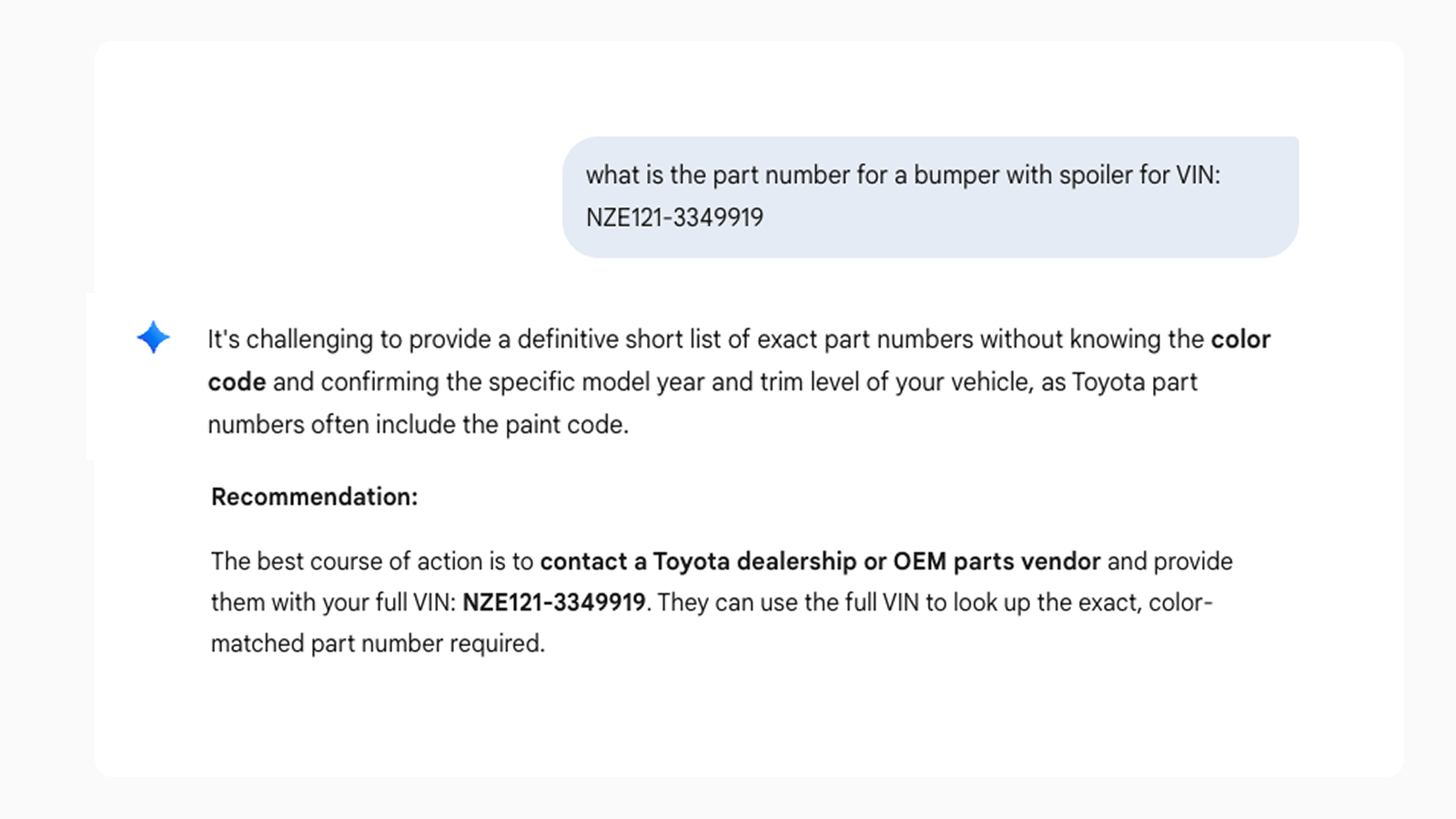
Until recently, solving these challenges at scale wasn't possible. The technology required to process millions of parts and vehicles across manufacturers accurately didn't exist.
Interpreter: Partly's Foundational Model
Partly has built Interpreter, a foundational model for parts.
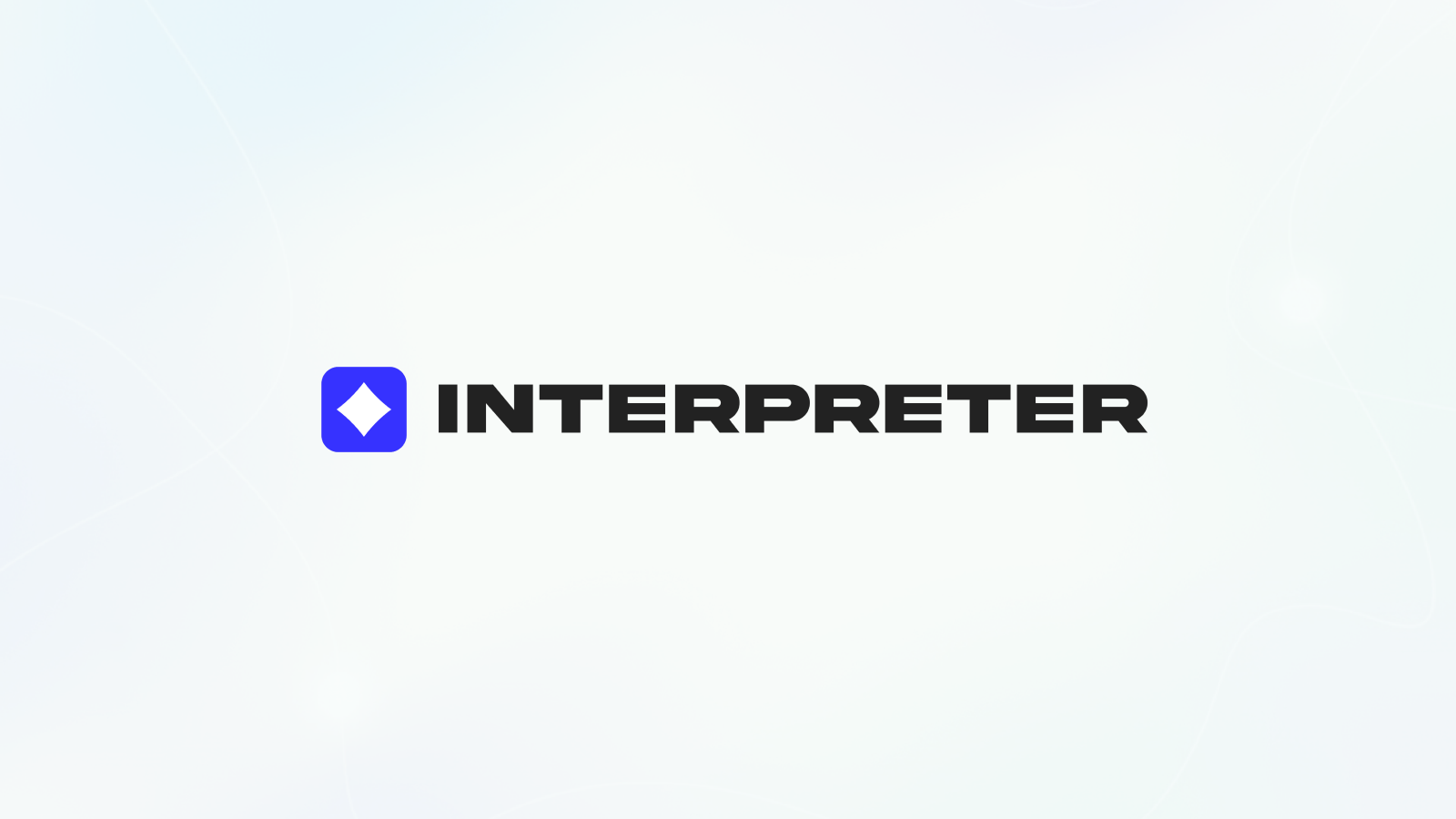
Interpreter understands text, diagrams, and images and complex relationships between vehicles and parts.
It can validate parts lists, flag errors, recommend parts, and identify required parts from damage capture or repair specifications.
This foundational model is at the core of all Partly's infrastructure, implemented through APIs or whitelabeled products that integrate into existing systems, making parts teams 10x more efficient and accurate.
How Interpreter is Built
Building Interpreter required investing years and millions to create foundational infrastructure from the ground up. This isn't an AI wrapper on existing catalogs.
High-Quality Data Sources
Partly builds its catalog from multiple verified sources: rigorous manual research by automotive experts, structured tear-downs of dismantled vehicles, government records, and licensed manufacturer data, not the fragmented, unreliable data available publicly online.
Universal Electronic Parts Catalog
Partly's automotive experts designed a universal standard for parts data and applied it across all makes and models. This solves a fundamental industry problem: every manufacturer structures their parts data differently, making cross-manufacturer accuracy nearly impossible. The catalog includes deep context that basic part numbers miss: assemblies, dependencies, part supersessions, policy requirements, and vehicle-specific variations.
Multimodal Training Architecture
Parts identification requires understanding multiple mediums simultaneously: technical diagrams, damage photos, and text descriptions. Interpreter is trained on all three, learning to recognize components visually, understand their relationships within assemblies, and connect information across formats the way human experts do.
Purpose-Built Software Tools
Building and maintaining this universal standard required creating entirely new tooling. We needed specialized software to enable expert labellers and researchers to annotate parts data at scale while maintaining exceptionally high standards. Partly developed tools that enable automotive experts to work efficiently, including:
- InterAnnotator: Data quality verification through expert review and consensus, with historical record keeping
- VehicleClassification: Vehicle parts classification workflow across manufacturers
- VariantsDisambiguation: Identifying and resolving ambiguities in vehicle identifiers and parts data.

These aren't adapted from general-purpose software. They're purpose-built for the specific challenges of standardizing automotive parts data across manufacturers.
Automotive Experts in the Loop
Domain experts continuously refine and verify the data, ensuring accuracy improves with each deployment. When edge cases arise, experts intervene directly through the annotation platform, solving issues and teaching the system for future encounters.
Performance Benchmarks from Real-World Applications
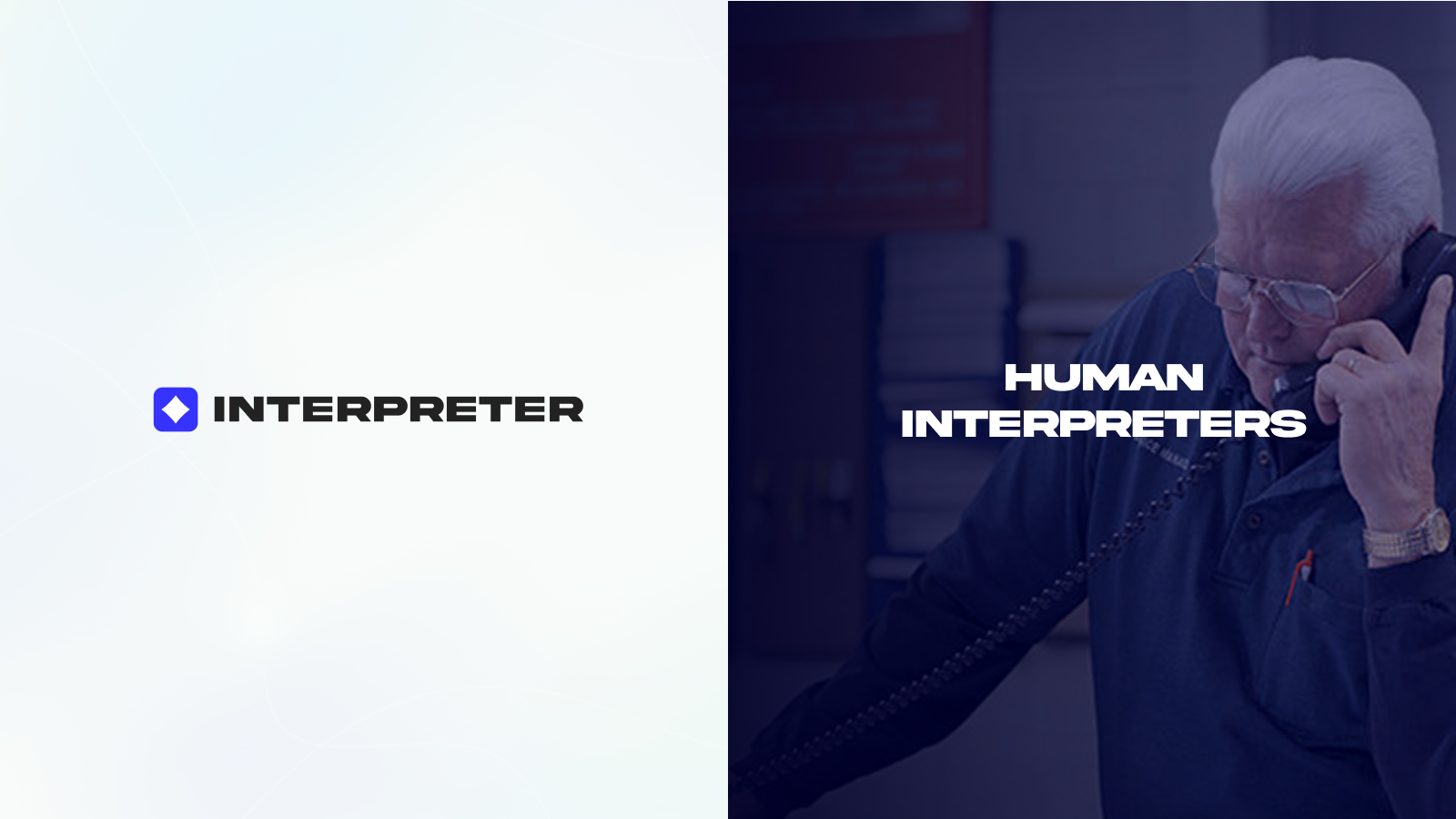
Interpreter is deployed and actively used by customers across multiple applications. To validate its performance, we conducted comprehensive benchmarking against traditional manual interpretation processes. This primarily involved analysis of historical performance data, supplemented by time-motion studies observing human interpreters.
This infrastructure enables performance that exceeds manual interpretation:
Results Across Applications
These results reflect actual performance data from 100,000+ real jobs:
- 2.7x fewer supplementaries (additional parts needed mid-job to complete the repair)
- 2.4x fewer errors (wrong parts ordered)
- 9x faster to manage collision orders
- 25x faster to price service jobs
How Customers Deploy Interpreter
Interpreter integrates into existing systems across the parts supply chain. It works behind the scenes, validating parts lists, identifying errors, and finding missing components. Businesses deploy it across order management systems, trade portals, catalogues, and estimation tools. The following examples show three core capabilities:
Parts Validation

What: Parts lists from estimation systems are known for containing inaccurate or incomplete information. Parts teams spend significant time manually checking every order against EPCs, often 30-45 minutes per estimate, driving up operational costs.
Even with this effort, errors still slip through. When they do, the resulting supplementaries and returns are costly and create friction between repairers and suppliers.
How: Interpreter automatically validates parts lists against VIN data, flagging incorrect part numbers and identifying missing components.
For Repairers: Teams can review flagged items before ordering, or enable automated corrections for high-confidence changes.
For Suppliers: Orders arrive structured and pre-validated with higher confidence. Interpreter explains why parts were validated or flagged, with diagram references for context. This integrates with dealer management systems, enabling automated processing workflows.
The result is more efficient operations on both ends of the transaction.
Vehicle Estimation (aka Blueprinting)
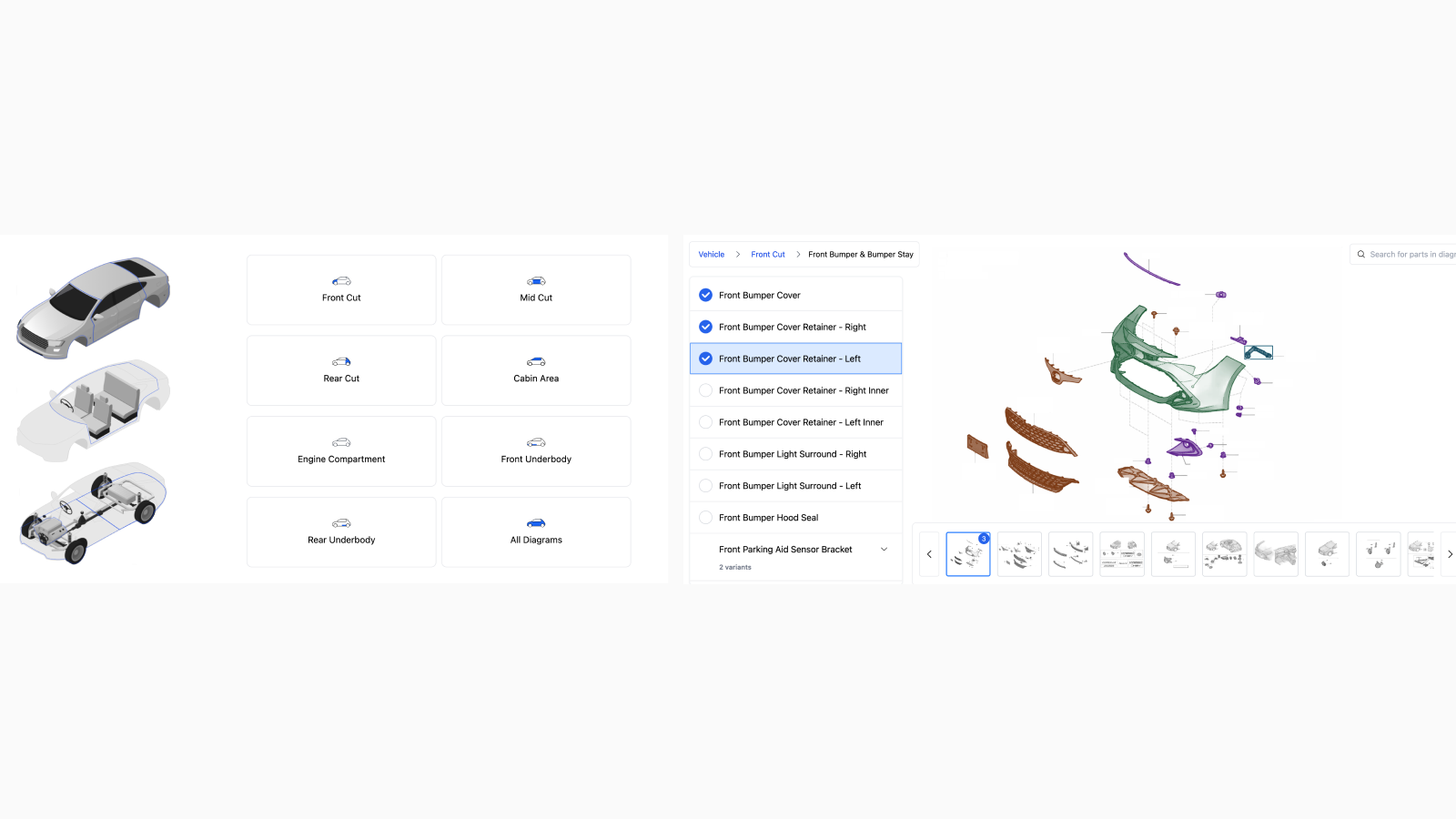
What: Estimators working without estimation software create parts lists from scratch, without catalog access. This results in incomplete estimates with key gaps:
- Missing smaller hardware and optional components
- Missing single-use parts required by manufacturers
- Incorrect or missing part numbers preventing accurate sourcing
- Recycled parts and assemblies that don't match standard catalog structures
These gaps lead to costly supplementaries and repair delays.
How: Interpreter powers tools that help estimators build complete, accurate parts lists. Using damage photos and repair descriptions, estimators work with interactive diagrams showing all required components, with correct part numbers for the specific VIN and live pricing and availability from suppliers.
Parts Counter Sales
Note: This applies to service jobs.
What: Parts teams juggle multiple systems and search across different manufacturer catalogs to price service jobs. This manual process is time-consuming and complex, especially for unfamiliar vehicles or service procedures.
How: Interpreter enables parts teams to enter a VIN and select the service job, instantly returning the correct parts with sourcing options from internal inventory. The system cross-references multiple data sources in seconds, work that traditionally takes hours of manual catalog research.
Conclusion
The collision parts industry is entering a new era. Domain-specific AI has moved from possibility to reality, and early adopters are already seeing measurable results. As the technology continues to improve and more companies deploy these solutions, the competitive advantage will compound. Faster operations, higher accuracy, and better customer experiences will define the industry's future leaders.
Ready to explore how domain-specific AI can transform your parts operations?
Contact Partly to learn more about our AI Infrastructure.

